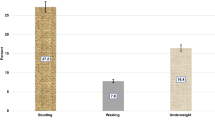Abstract
Objectives: To determine whether the socioeconomic and nutritional status of cured leprosy patients with residual deformity, and their household members, was lower than that of cured leprosy patients without deformity.
Design: Cross-sectional study.
Subjects: One hundred and fifty-five index cases with deformity, 100 without deformity. Also 616 household members comprising 48% of the total members enumerated.
Measurements: Nutritional status was evaluated using anthropometry. Disease characteristics, socio-economic parameters and household information were recorded using a questionnaire.
Results: Index cases with deformity had lower community acceptance (P<0.001), and employment (P<0.001) than those cases without deformity. Households of index cases with deformity had a lower income (P<0.01) and a lower expenditure on food (P<0.05). The presence of deformity (odds ratio (OR): 2.1–3.2, P<0.01), unemployment (OR: 2.3–4.3, P<0.01) and female gender (OR: 2.4, P<0.01) significantly increased the risk of index cases being undernourished, as judged by body mass index (BMI) alone, or BMI and mid-upper arm circumference. A low BMI (<18.5) in the index case significantly increased the odds of other adults (OR 2.2), adolescents (OR 2.9–3.8) and children (OR 2.2) in the household being undernourished.
Conclusions: Cured leprosy index cases with physical deformity are more undernourished than index cases without deformity. This is associated with a reduced expenditure on food, possibly brought on by increased unemployment, and a loss of income. Undernutrition in the index case increases the risk of undernutrition in other members of the family.
Sponsorship: Deakin University, Melbourne, Australia.
European Journal of Clinical Nutrition (2000) 54, 643–649.
This is a preview of subscription content, access via your institution
Access options
Subscribe to this journal
Receive 12 print issues and online access
$259.00 per year
only $21.58 per issue
Buy this article
- Purchase on Springer Link
- Instant access to full article PDF
Prices may be subject to local taxes which are calculated during checkout
Similar content being viewed by others
Author information
Authors and Affiliations
Contributions
Guarantor: M Vaz.
Contributors: BD arranged funding, formulated the questionnaires, collected the data, did the primary analysis and wrote the first draft of the paper. MV conceived of the study, designed the methodology, oversaw the project and edited the paper. MJS provided methodological and statistical advice, edited the paper and arranged funding. AJWJ designed the operational strategies for data collection, provided logistic support in the field and edited the paper. LSP provided methodological and statistical advice and edited the paper.
Corresponding author
Rights and permissions
About this article
Cite this article
Diffey, B., Vaz, M., Soares, M. et al. The effect of leprosy-induced deformity on the nutritional status of index cases and their household members in rural South India: a socio-economic perspective. Eur J Clin Nutr 54, 643–649 (2000). https://doi.org/10.1038/sj.ejcn.1601068
Received:
Revised:
Accepted:
Published:
Issue Date:
DOI: https://doi.org/10.1038/sj.ejcn.1601068



